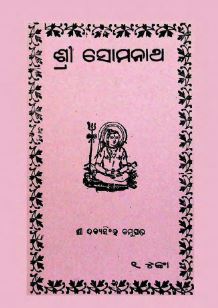The realm of Odia literature is adorned with exceptional works that encapsulate the rich cultural and spiritual tapestry of Odisha. One such noteworthy contribution is “Sri Somanath,” an essay book by the esteemed writer Dibyasingh Chamupati, published in 1988. This literary work is not merely a collection of essays but a profound exploration of the historical, cultural, and spiritual significance of the Somnath Temple, a monument revered in various traditions, particularly within Hinduism.
In “Sri Somanath,” Chamupati embarks on a meticulous journey to unravel the historical narratives surrounding the Somnath Temple, situated in Gujarat. The temple, dedicated to Lord Shiva, holds a significant place in Hindu mythology and Indian history. Chamupati’s essays are interwoven with tales of divine reverence, architectural grandeur, and the tumultuous history of the temple, which has witnessed numerous invasions and restorations. His adept storytelling paints a vivid picture of the temple’s resilience as a symbol of faith and devotion.
The essays reflect deep research and thoughtful introspection, allowing readers to delve into the layers of cultural heritage embedded within the temple’s structure. Chamupati articulates the architectural beauty of Somnath, describing its intricate carvings and magnificent spires that stand as testaments to the artistry of ancient craftsmen. He elucidates how each element of the temple contributes to an overarching narrative of divinity, drawing parallels between the physical embodiment of the temple and the spiritual significance it holds for devotees.
Chamupati does not merely focus on the architectural and historical aspects; he also keenly emphasizes the temple’s role as a cultural icon. The Somnath Temple is portrayed as a unifying force that transcends regional and communal boundaries, attracting pilgrims from diverse backgrounds. Through personal anecdotes and reflections, the writer captures the essence of pilgrimage, inviting readers to understand the temple as a site of spiritual rejuvenation and communal harmony.
He elaborates on the rituals and traditions associated with the temple, illustrating how they foster a sense of belonging and spiritual connection among devotees. The essay book serves as an invitation to readers to reflect on their spiritual journeys, encouraging them to engage with the divine through the lens of Somnath’s legacy
In “Sri Somanath,” Dibyasingh Chamupati encapsulates the myriad dimensions of the Somnath Temple, weaving together history, architecture, spirituality, and culture into a coherent narrative. His writing not only honors the past but also calls for the preservation of this sacred site as a symbol of resilience and faith. The essays resonate with a timeliness that appeals to contemporary readers, reminding us of the importance of cultural heritage in shaping our identities and values.
As we turn the pages of “Sri Somanath,” we are invited to contemplate our connections to the divine and the historical narratives that shape our understanding of spirituality. Chamupati’s work stands as an essential contribution to Odia literature, enriching our appreciation for the temple and encouraging a deeper exploration of our cultural roots. Through this literary odyssey, readers become part of the enduring legacy of Somnath, inspired to embark on their own spiritual journeys.
Books Info
| Books name | Sri Somanath |
| Author | Dibyasingh Chamupati |
| No Of pages | 21 |
| Publisher | NA |
| Publication | 1988 |
| Printed At | NA |
| Distributor | NA |

